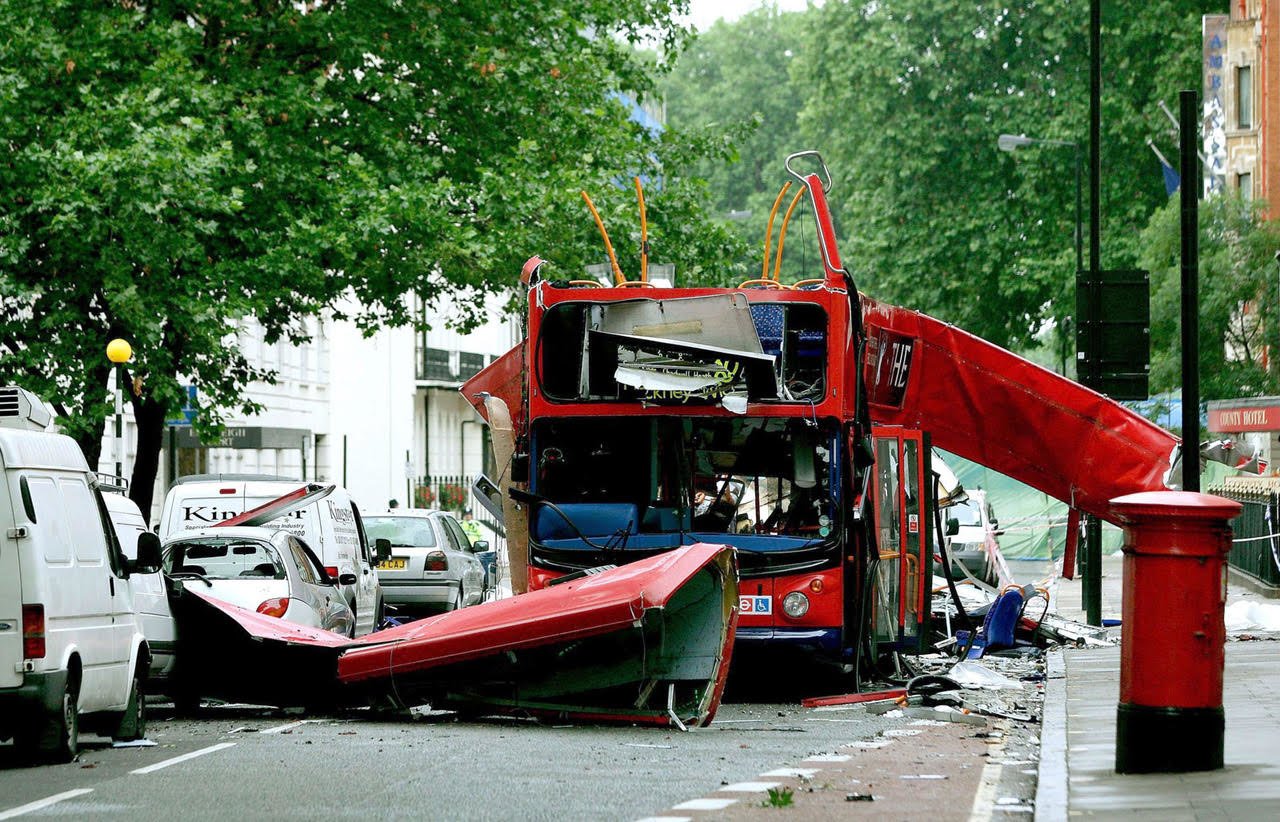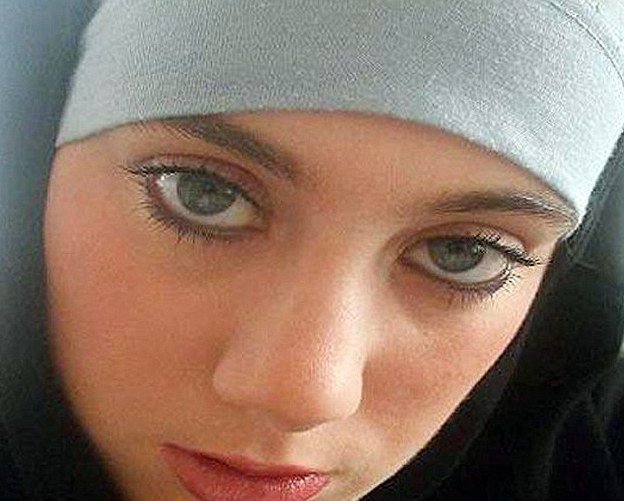
Wreckage of a double-decker bus destroyed by a suicide bomb detonated in Tavistock Square, London, part of a coordinated terrorist attack on that city on July 7, 2005, known as 7/7. Image from Britannica.com.
Despite heavy rain that morning, July 7, 2005, was a day when Londoners had reason to be cheery. The day before, the city had learned it would host the 2012 Summer Olympic Games, while the G-8 summit had just begun in Scotland — two showy turns under the spotlight of the international stage.
At 7:15 a.m., four men entered Luton Station, a suburban railway stop for commuters heading to and from London. The four carried backpacks and were dressed casually. Standing on the platform, Shehzad Tanweer, 24, leaned forward and tugged on the straps of his heavy rucksack. Other passengers would distinctly remember the men standing out on the platform, because of their backpacks, casual clothes during London’s buttoned-up rush hour, and silent demeanor. But most wrote them off as tourists. At 8:30, footage shows the four men hugging — their demeanor happy, euphoric even.
The four boarded separate trains and, once seated, set their backpacks at their feet. At 8:50, bombs inside three of the backpacks detonated on three separate packed trains. At Liverpool Street, Tanweer, sitting down, detonated his device, killing eight people, including himself, and injuring 171. At Edgware Road, Mohammad Sidique Khan, 30, killed seven and injured 163. On the Piccadilly line, Germaine Lindsay, 19, was standing when he detonated his device, killing 27 and injuring more than 340.

One suicide bomber still remained. Five minutes after the initial round of blasts, Hasib Hussain, 18, tried unsuccessfully to reach the others by phone. At 9 a.m., a CCTV camera saw him enter a W.H. Smith at King’s Cross station, where he bought a 9-volt battery. By then, London’s train system had been shut down so Hussain boarded a double-decker bus, heading east, and sat in the upper level. Passengers noticed him repeatedly “fiddling” with his backpack. At 9:47, he detonated his device, killing 14 and injuring 110.
The four bombs were relatively simple improvised explosive devices, made from triacetone triperoxide (TATP), 9-volt batteries, and nails. In all, besides the bombers themselves, 52 were killed in the attacks, hundreds injured, and London crippled for days.
In the aftermath of the attack, London’s emergency services faced fierce scrutiny for their response time to the multiscene terrorist attack. It took rescuers 52 minutes to respond to Tavistock Square, the scene of the bus attack. Only half of London’s 201 ambulances were dispatched to the attack scenes. One group of firefighters refused to enter the underground until they received official word that the third rail was shut off. A police officer stood on the rail in an effort to coax them down to help, but they refused, saying they needed official word from London Underground management.

7/7
The shorthand for today’s date — 7/7 — is as engraved in British consciousness as 9/11 is in America.
The UK had been at war for four years prior to the 7/7 bombings but almost entirely in the service of its ally, the US. The 7/7 bombings brought the War on Terror to English shores. Months later, al Qaeda’s No. 2, Ayman al-Zawahri, claimed responsibility for the attack and shared a farewell statement from one of the bombers on Al-Jazeera. He blamed the attacks on Prime Minister Tony Blair’s decision to deploy troops to Iraq. In the months afterward, the United Kingdom implemented several changes to its intelligence sharing, emergency response, and community outreach, but questions still linger: How did the four bombers avoid the detection of intelligence services, and were others involved?
The bombers were characterized during the investigation as “ordinary British citizens.” In reality, they were anything but. Though they were British citizens from largely typical English immigrant families, Tanweer, Hussain, Khan, and Lindsay all ran in extremist circles. Tanweer, Hussain, and Khan were born to Muslim Pakistani parents and chose a radical path, but Lindsay was born in Jamaica and immigrated to the UK with his mother when he was 1 year old. While their families lived typical lives in and near the working-class city of Leeds in Yorkshire, the four men had formed an al Qaeda-linked terror cell.
In 2000, at age 15, Lindsay turned toward Islam, at the urging of his mother, a recent convert herself. He embraced it with fervor. Lindsay quickly became fluent in Arabic and committed long passages of the Quran to memory. In his teens, Lindsay began listening to recorded extremist sermons and attended at least one speech by the internationally banned purveyor of hate speech, Abdullah el-Faisal. According to the Anti-Defamation League, el-Faisal peddled his fiery brand of Jihadi-Salafi extremism in the UK and also in the United States, through a group called Revolution Muslim, according to the ADL. El-Faisal openly preached and advocated for the killing of Christians, Jews, Hindus, and Americans. His message was simple:
“Democracy is not the way forward. The only way to liberate land and man is Jihad. The way forward is the bullet. Our motto is, ‘Might is right.'”
Not long after embracing the radical teachings of el-Faisal, Lindsay was disciplined at school. He was caught distributing leaflets in support of al Qaeda. At some point in 2004, Lindsay met the alleged ringleader of the bombers, Mohammad Sidique Khan, while moving in the same Islamist circles in Dewsbury and Huddersfield.
Khan was raised in Leeds, where he worked as a teacher’s assistant and served as a mentor in a local mosque. During the early 2000s, Khan traveled back and forth to Pakistan for training hosted by al Qaeda militants. Prior to the bombings, agents at MI5 — the British internal security service, akin to the FBI — had monitored Khan on four separate occasions between February and March of 2004. Khan was suspected of being associated with a terrorist group that was planning to build a fertilizer bomb for a separate plot that was foiled by police. Authorities also had monitored Tanweer for consorting with this group.
By now, Lindsay was married and had a child with another convert whom he’d met online, Samantha Lewthwaite. Lewthwaite grew up in England and, after her parents divorced, converted to Islam. The two hit it off after meeting at the “Stop the War” march in Hyde Park, London. They married soon after. Lindsay worked as a carpet fitter and also sold mobile phone covers. Later they moved to Aylesbury, where Lewthwaite was raised. But the couple broke off most contact with her family. A week prior to the attack, Lewthwaite told friends she had thrown Lindsay out for having an affair.
The White Widow

Seven days after the attack, Lewthwaite, seven months pregnant, contacted the police to report her husband missing. She initially denied that he could be involved in the attack, saying, “He was innocent, naïve, and a simple man.” When investigators confided that they had DNA evidence, she conceded it could be possible. Investigators believed she knew more than she was saying but couldn’t prove it.
Lewthwaite wasted no time selling her story to the Daily Mail for 30,000 pounds. She stuck to her claim that she had no idea of his plot and stated that what he did was “abhorrent.” Once her name was public, she had to be placed in a safe house by officials after her home was firebombed.
Soon she gave birth to her son, naming him Shahid, a name that can be used in Arabic as shorthand for a martyr. Lewthwaite slipped out of the UK with a fake ID and next surfaced in Somalia with the terrorist group al-Shabab. She has been implicated in several terrorist attacks since, including a grenade attack in Mombasa in 2012 and the Westgate Mall attack in 2013 that left more than 70 dead. Today she is known as the White Widow and has a Red Notice Arrest Warrant from Interpol.
To date, crown prosecutors have tried several conspirators for the 7/7 bombings, but none have been convicted. In 2009, prosecutors brought three associates of the bombers to trial on charges of aiding the bombers in scouting locations for attacks. All three were found not guilty by a jury and released.
A report in 2014 said Samantha Lewthwaite had been killed in Ukraine, but authorities currently believe she is at large in Somalia or Kenya.
Read Next:

David Bruce is a retired federal law enforcement officer. Throughout his career, he served mostly in counterterrorism roles and tactical instructor positions. As a task force officer for the Boston Joint Terrorism Task Force (JTTF), he spent more than five years investigating domestic and international terrorism cases. Prior to his assignment on the JTTF, he served as the lead instructor for the Boston Office of the Federal Air Marshal Service teaching anti-hijacking tactics, firearms, and tactical surveillance. In 2019, David graduated from UMass Amherst with a degree in journalism. Before embarking on a 25-year career in law enforcement, he served in the US Army as a paratrooper/combat medic in the 82nd Airborne Division.
BRCC and Bad Moon Print Press team up for an exclusive, limited-edition T-shirt design!
BRCC partners with Team Room Design for an exclusive T-shirt release!
Thirty Seconds Out has partnered with BRCC for an exclusive shirt design invoking the God of Winter.
Lucas O'Hara of Grizzly Forge has teamed up with BRCC for a badass, exclusive Shirt Club T-shirt design featuring his most popular knife and tiomahawk.
Coffee or Die sits down with one of the graphic designers behind Black Rifle Coffee's signature look and vibe.
Biden will award the Medal of Honor to a Vietnam War Army helicopter pilot who risked his life to save a reconnaissance team from almost certain death.
Ever wonder how much Jack Mandaville would f*ck sh*t up if he went back in time? The American Revolution didn't even see him coming.
A nearly 200-year-old West Point time capsule that at first appeared to yield little more than dust contains hidden treasure, the US Military Academy said.












